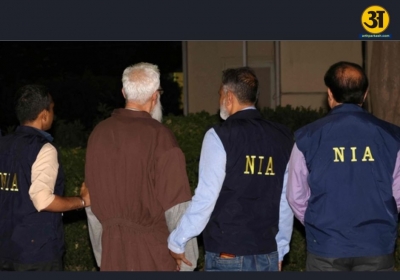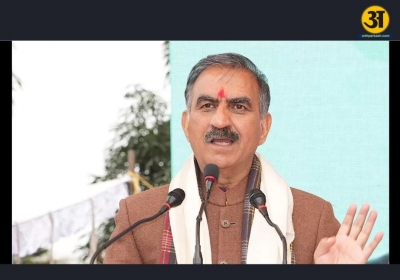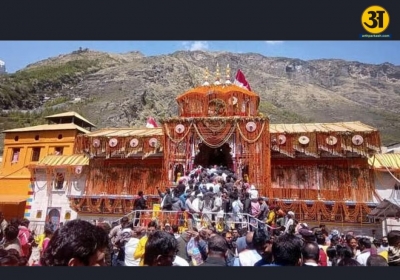.jpeg)
PM modi pays tribute to Netaji on his 125th birth anniversary.
PM presents a hologram statue of Netaji at India Gate.
PM Narendra Modi stated on Sunday after unveiling a hologram statue of Netaji Subhash Chandra Bose at India Gate that there has been an attempt to erase the contributions of various great persons in Indian history, as well as the country’s culture. He claimed that the country was now “boldly correcting this mistake.”
“The five pilgrimage sites related with Baba Saheb Bhimrao Ambedkar are now being developed across the country. In honour of Sardar Vallabhbhai Patel, the Statue of Unity has become a pilgrimage site. One of the Andaman Islands has been named after Netaji. In his honour, a memorial has been erected there. It’s a homage not only to Netaji but also to the Indian National Army’s jawans,” Modi remarked.
On the 125th anniversary of Netaji Subhas Chandra Bose’s birth, Prime Minister Narendra Modi paid floral tributes to him in the central hall of Parliament on January 23, 2022. The Republic Day celebrations will begin on January 23rd, the birth anniversary of Netaji, and end on January 30th, Mahatma Gandhi’s death anniversary.
On January 21st, Prime Minister Modi stated that a large statue of Netaji Subhas Chandra Bose would be erected near India Gate as a symbol of the country’s “indebtedness” to him. The statue is expected to stand 28 feet tall and 6 feet wide. Granite will be used to construct it.
A hologram statue of him will be present in the same location until the statue is installed. On the 125th anniversary of Netaji’s birth, Prime Minister Modi presented the hologram statue.
Parakram Diwas
Last year, to mark Netaji Subhas Chandra Bose’s 125th birthday, the federal government designated January 23rd as Parakram Diwas.
On the day, Prime Minister Modi tweeted, “On the anniversary of his Jayanti, I bow to Netaji Subhas Chandra Bose. Every Indian is proud of what he has done for our country.”
“I had the great privilege of visiting Netaji’s paternal residence in Kolkata last year,” Modi added, elaborating on the government’s efforts to remember Netaji. And the experience I had is difficult to put into words. In 2018, I unfurled the national flag at Red Fort while wearing the INA cap. We’re also working on a Red Fort INA memorial. It was also our government’s good fortune that we were given the opportunity to make public Netaji’s archives.
“The Netaji statue to be erected here will continue to inspire generations of courage, patriotism, and sacrifice,” Home Minister Amit Shah said. This will be more than a stone statue; it will be a representation of the nation’s love for Netaji. Many of the individuals who fought for India’s independence have been pushed into obscurity. However, the nation is satisfied and enthusiastic now as a result of the decision to erect a statue of Netaji here.
Netaji Subhas Chandra Bose: Know all about him by 10 points
1. Netaji Subash Chandra Bose, who was born on January 23, 1897, was a key figure in India’s war for independence. He founded the Azad Hind Fauj to aid in the liberation of India from British rule. In early 1942, Indian soldiers in Germany appended the honorific title of Netaji to his name for the first time.
2. Subhash Chandra Bose was born into a wealthy Bengali family in Orissa and was sent to England after college to take the Indian Civil Service examination. He dropped out of school after passing the first exam, citing nationalism as a greater calling.
3. In 1921, he returned to India and joined Mahatma Gandhi’s Indian nationalist movement.
4. He was elected President of the INC in 1938, but after re-election in 1939, he and Gandhi fell out, and Bose resigned as President and was later expelled from the party.
5. He arrived in Nazi Germany in 1941 seeking German assistance to free India, and the German leadership showed unexpected sympathy and support for India’s independence. Bose was able to raise funding and form the Azad Hind Fauj, which was originally a branch of the German Army and was meant to act as a liberation force for British-ruled India.
6. In Europe, the Azad Hind Fauj recruited Indian POWs and expats. The first recruits were Indian student residents in Germany who volunteered, as well as a few Indian prisoners of war seized during the North African campaign. Later, other Indian prisoners of war volunteered to join the Legion.
7. The Azad Hind Fauz planned to invade India by land. In late May 1942, Adolf Hitler, who had already visited Bose, promised to arrange for a submarine for him. In February 1943, Bose boarded a German submarine before being transferred to a Japanese submarine, from which he disembarked in Japanese-controlled Sumatra in May 1943.
8. He reformed the Indian National Army (INA) with the help of the Japanese, which included Indian prisoners of war from the British Indian army who had been taken by the Japanese during the Battle of Singapore.
9. The British Indian Army halted the Japanese attack on India in late 1944 and early 1945, killing nearly half of the Japanese forces and INA contingent. The remaining forces were driven out to the Malay Peninsula and surrendered with the recapture of Singapore.
10. Bose is said to have fled to Manchuria in search of asylum in the Soviet Union. According to sources, he perished on August 18, 1945, when his overloaded plane crashed in Taiwan. Despite the fact that some Indians do not think the crash ever happened.
https://arthparkash.com/english/netajis-forward-bloc-is-wavering-amid-financial-difficulties
https://arthparkash.com/english/73rd-republic-day-rehearsals-and-celebrations-begin





